Neuronal cell fate specification by the molecular convergence of different spatio-temporal cues on a common initiator terminal selector gene
- PMID: 28414802
- PMCID: PMC5411104
- DOI: 10.1371/journal.pgen.1006729
Neuronal cell fate specification by the molecular convergence of different spatio-temporal cues on a common initiator terminal selector gene
Abstract
The extensive genetic regulatory flows underlying specification of different neuronal subtypes are not well understood at the molecular level. The Nplp1 neuropeptide neurons in the developing Drosophila nerve cord belong to two sub-classes; Tv1 and dAp neurons, generated by two distinct progenitors. Nplp1 neurons are specified by spatial cues; the Hox homeotic network and GATA factor grn, and temporal cues; the hb -> Kr -> Pdm -> cas -> grh temporal cascade. These spatio-temporal cues combine into two distinct codes; one for Tv1 and one for dAp neurons that activate a common terminal selector feedforward cascade of col -> ap/eya -> dimm -> Nplp1. Here, we molecularly decode the specification of Nplp1 neurons, and find that the cis-regulatory organization of col functions as an integratory node for the different spatio-temporal combinatorial codes. These findings may provide a logical framework for addressing spatio-temporal control of neuronal sub-type specification in other systems.
Conflict of interest statement
The authors have declared that no competing interests exist.
Figures
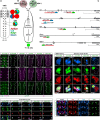
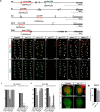

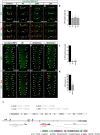
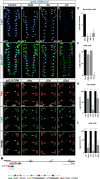


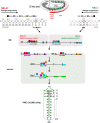
Similar articles
-
Neuronal Cell Fate Specification by the Convergence of Different Spatiotemporal Cues on a Common Terminal Selector Cascade.PLoS Biol. 2016 May 5;14(5):e1002450. doi: 10.1371/journal.pbio.1002450. eCollection 2016 May. PLoS Biol. 2016. PMID: 27148744 Free PMC article.
-
Specification of neuronal identities by feedforward combinatorial coding.PLoS Biol. 2007 Feb;5(2):e37. doi: 10.1371/journal.pbio.0050037. PLoS Biol. 2007. PMID: 17298176 Free PMC article.
-
A branching gene regulatory network dictating different aspects of a neuronal cell identity.Development. 2019 Mar 15;146(6):dev174300. doi: 10.1242/dev.174300. Development. 2019. PMID: 30837222
-
Brn3/POU-IV-type POU homeobox genes-Paradigmatic regulators of neuronal identity across phylogeny.Wiley Interdiscip Rev Dev Biol. 2020 Jul;9(4):e374. doi: 10.1002/wdev.374. Epub 2020 Feb 3. Wiley Interdiscip Rev Dev Biol. 2020. PMID: 32012462 Review.
-
Together at last: bHLH and LIM-HD regulators cooperate to specify motor neurons.Neuron. 2003 Jun 5;38(5):675-7. doi: 10.1016/s0896-6273(03)00329-5. Neuron. 2003. PMID: 12797950 Review.
Cited by
-
Dynamics of transcriptional (re)-programming of syncytial nuclei in developing muscles.BMC Biol. 2017 Jun 9;15(1):48. doi: 10.1186/s12915-017-0386-2. BMC Biol. 2017. PMID: 28599653 Free PMC article.
-
Dachshund acts with Abdominal-B to trigger programmed cell death in the Drosophila central nervous system at the frontiers of Abd-B expression.Dev Neurobiol. 2022 Sep;82(6):495-504. doi: 10.1002/dneu.22894. Epub 2022 Jul 10. Dev Neurobiol. 2022. PMID: 35796156 Free PMC article.
-
Anterior CNS expansion driven by brain transcription factors.Elife. 2019 Jul 4;8:e45274. doi: 10.7554/eLife.45274. Elife. 2019. PMID: 31271353 Free PMC article.
-
Integration of Spatial and Temporal Patterning in the Invertebrate and Vertebrate Nervous System.Front Neurosci. 2022 Mar 22;16:854422. doi: 10.3389/fnins.2022.854422. eCollection 2022. Front Neurosci. 2022. PMID: 35392413 Free PMC article. Review.
-
40 years of homeodomain transcription factors in the Drosophila nervous system.Development. 2024 Jun 1;151(11):dev202910. doi: 10.1242/dev.202910. Epub 2024 May 31. Development. 2024. PMID: 38819456 Free PMC article. Review.
References
-
- Hobert O. Regulatory logic of neuronal diversity: terminal selector genes and selector motifs. Proceedings of the National Academy of Sciences of the United States of America. 2008;105(51):20067–71. Epub 2008/12/24. PubMed Central PMCID: PMC2629285. doi: 10.1073/pnas.0806070105 - DOI - PMC - PubMed
-
- Wenick AS, Hobert O. Genomic cis-regulatory architecture and trans-acting regulators of a single interneuron-specific gene battery in C. elegans. Developmental cell. 2004;6(6):757–70. Epub 2004/06/05. doi: 10.1016/j.devcel.2004.05.004 - DOI - PubMed
-
- Sharma K, Sheng HZ, Lettieri K, Li H, Karavanov A, Potter S, et al. LIM homeodomain factors Lhx3 and Lhx4 assign subtype identities for motor neurons. Cell. 1998;95(6):817–28. - PubMed
-
- Thor S, Andersson SG, Tomlinson A, Thomas JB. A LIM-homeodomain combinatorial code for motor-neuron pathway selection. Nature. 1999;397(6714):76–80. doi: 10.1038/16275 - DOI - PubMed
MeSH terms
Substances
LinkOut - more resources
Full Text Sources
Other Literature Sources
Molecular Biology Databases
Research Materials
Miscellaneous

